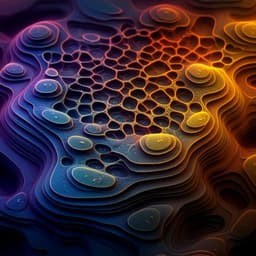Introduction
The interaction of intense ultrashort light pulses with transparent materials, particularly silica glass, has led to advancements in various fields including laser surgery, three-dimensional integrated optics, microfluidics, and optical data storage. A key phenomenon observed is the formation of self-assembled nanolamella structures (nanogratings) aligned perpendicular to the laser beam's polarization. These nanostructures induce optical anisotropy, making the material birefringent. This birefringence, along with other properties like retardance and slow axis orientation, has been explored for applications such as polarization shaping and 5D optical data storage. While most research uses linearly polarized light, this study investigates the use of elliptical polarization to improve efficiency. Previous research has shown varying results regarding the polarization dependence of photoionization, with some studies showing higher rates for linear polarization at lower intensities and higher rates for circular polarization at higher intensities. This paper challenges the conventional wisdom that linear polarization is most effective for creating birefringence by exploring the potential of elliptical polarization.
Literature Review
The literature review covers existing methods for birefringence patterning, including the alignment of liquid crystals and lithography. It also discusses various multiplexed data storage techniques such as those employing fluorescence of silver clusters, plasmonic properties of metallic nanoparticles, and laser writing in optically active polymers or transparent plastics. The advantages of 5D optical data storage based on direct writing in silica glass, offering high data capacity and virtually unlimited lifetime, are highlighted. Prior work on ultrafast laser writing with circular and elliptical polarization is reviewed, noting the formation of different structures in various materials like CaF2, ZnO, and ZnSe crystals, as well as the fabrication of capillaries in silica glass. The polarization dependence of photoionization in fused silica has also been studied, showing different ionization rates for linear and circular polarization at varying intensities.
Methodology
Birefringent voxels were created using femtosecond laser pulses (300 fs duration, 1 MHz repetition rate, 1030 nm wavelength) with varying ellipticities (0 to 1). The pulse energy was 200 nJ (intensity 9.8 TW/cm²) for some experiments and 220 nJ (10.8 TW/cm²) for others. A 0.3 NA lens was used for focusing. The retardance of the birefringent voxels was measured as a function of ellipticity and the number of pulses. Nonlinear absorption measurements were performed for single pulses and for the 30th pulse in a sequence to study the effect of accumulated defects. The birefringence was estimated from the retardance and the structure length. Larger birefringent structures (20x20 µm squares) were also written using raster scanning with different ellipticities, pulse durations (300 fs and 600 fs), and energies. Scanning electron microscopy (SEM) was used to image the nanostructures after polishing and etching. The effect of ellipticity on nanopore formation was analyzed by comparing SEM images of structures written with linear and elliptical polarization.
Key Findings
The study's key findings are: 1. Elliptical polarization resulted in significantly higher retardance (up to 1.5 nm) compared to linear polarization (around 1 nm), despite lower absorption (2% vs 5%). 2. The optimal ellipticity for maximum retardance was around 0.6. 3. At higher pulse energies (220 nJ), a transition from type X (nanopore) modification to type II (nanograting) modification was observed with decreasing ellipticity. 4. The use of elliptical polarization increased the retardance of larger birefringent structures (up to 70 nm compared to 55 nm with linear polarization). 5. SEM images showed a larger concentration and size of anisotropic nanopores for structures written with elliptical polarization. 6. The increased birefringence with elliptical polarization is attributed to the combined effects of the linear component (flattening nanopores) and the circular component (efficient nanopore formation through cavitation and density reduction). 7. The higher energy of free electrons generated by circularly polarized light (2.15 eV vs 0.34 eV for linear polarization) contributes to efficient nanopore formation. 8. The circular component of elliptical polarization enhances the excitation of randomly oriented dipolar absorbing species (defects), which promotes efficient tunneling ionization.
Discussion
The results challenge the conventional understanding of light-matter interaction in ultrafast laser writing. The higher birefringence achieved with elliptical polarization, despite lower absorption, demonstrates a novel mechanism for efficient nanopore formation. The combined effects of linear and circular components of elliptical polarization are crucial in maximizing the number of photoionized sites and creating more pronounced anisotropic nanopores. This work offers a pathway to significantly enhance the speed and efficiency of fabricating birefringent optical elements, potentially leading to improvements in applications such as polarization shaping and multiplexed data storage.
Conclusion
This study demonstrates that elliptical polarization significantly enhances the efficiency of ultrafast laser writing for creating birefringent structures in silica glass. The higher retardance achieved with elliptical polarization compared to linear polarization, despite lower absorption, opens new avenues for high-throughput fabrication of polarization-shaping devices and advanced optical data storage. Future research could investigate the optimal parameters for different applications and explore the use of elliptical polarization in other transparent materials.
Limitations
The study primarily focused on silica glass. The findings may not be directly generalizable to other materials. The SEM images provide estimates of nanopore size after etching, which may not perfectly represent the initial nanopore dimensions. Further investigation is needed to fully understand the complex interplay between light polarization, electron dynamics, and nanopore formation.
Related Publications
Explore these studies to deepen your understanding of the subject.







